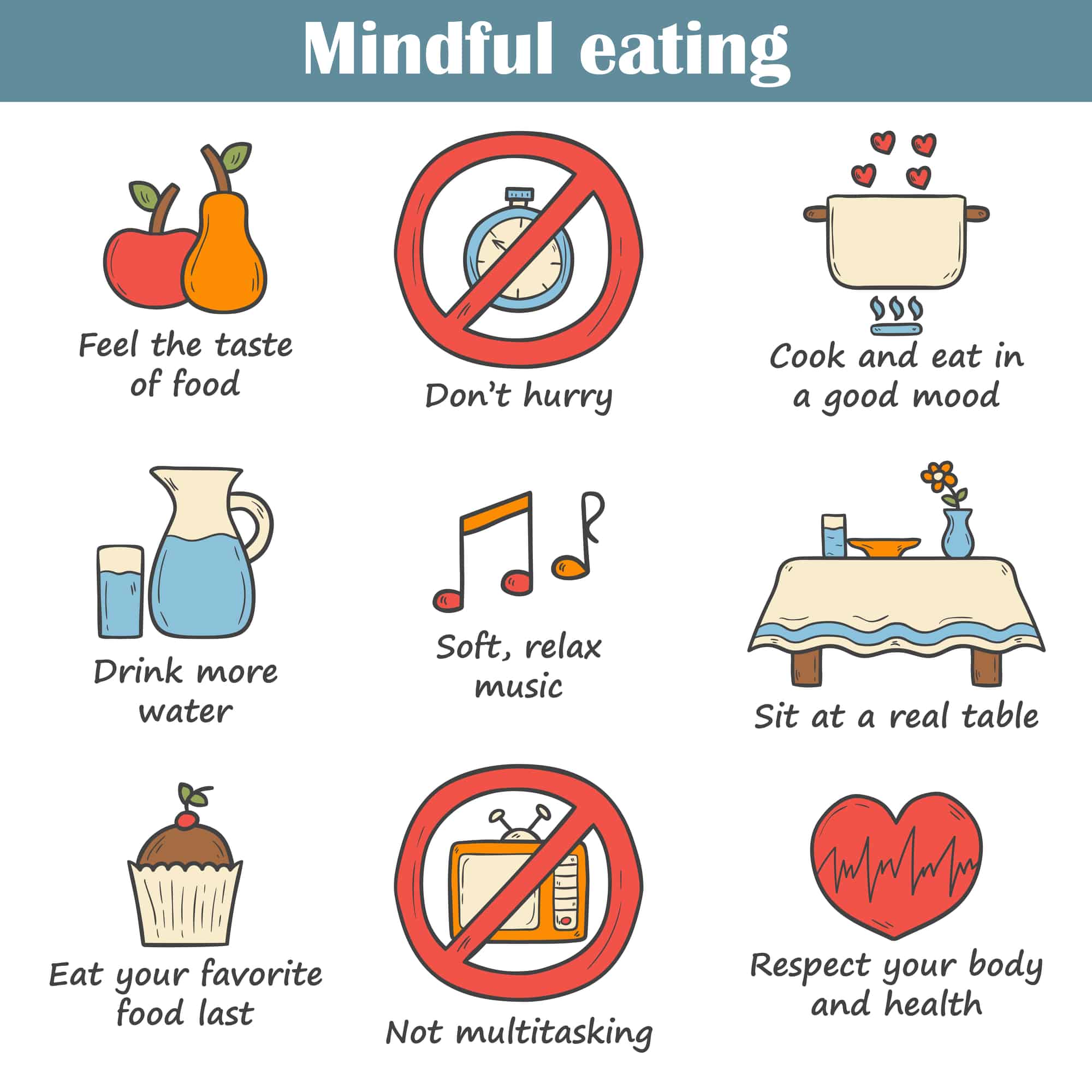Mindful eating is the practice of bringing full attention to the experience of eating—to the colors, smells, tastes, and textures of your food, as well as to your body’s hunger and fullness cues. Rooted in Buddhist mindfulness, it’s not a diet, but rather a powerful shift in awareness. Instead of following strict rules, you learn to listen to your body and eat with intention and non-judgment. Research from sources like the Harvard T.H. Chan School of Public Health shows that mindful eating can help reduce binge eating, support sustainable weight management, and transform your relationship with food for the better. If you’re looking for a practical way to begin, exploring a simple mindful eating exercise can be an excellent first step.
What Is Mindful Eating?
At its core, mindful eating is about applying mindfulness to food and the act of eating. Unlike traditional diets that focus on what you eat, mindful eating emphasizes how and why you eat. It’s about slowing down and tuning into the entire process, from noticing the first signs of hunger to recognizing when you are comfortably full. The goal isn’t restriction; it’s awareness.

Core Principles of Mindful Eating
Mindful eating is built on several key principles that work together to foster a healthier, more conscious connection with your food:
- Eating Slowly and Deliberately: Taking your time to chew thoroughly and savor each bite.
- Listening to Physical Hunger: Learning to recognize true hunger signals (like a gentle stomach growl) versus non-hunger triggers like boredom or stress.
- Engaging All Senses: Noticing the sight, smell, sound, touch, and taste of your food.
- Coping with Food-Related Guilt: Acknowledging your feelings about food without judgment or shame.
- Eating Without Distraction: Turning off the TV, putting away your phone, and focusing solely on your meal.
- Appreciating Your Food: Reflecting on where your food came from and the effort it took to bring it to your plate.
The Science Behind Mindful Eating
The effectiveness of mindful eating is backed by science. When you eat distractedly, your brain doesn’t fully register the meal, which can lead to overeating. By eating mindfully, you allow your brain to catch up with your stomach. It takes about 20 minutes for satiety signals to travel from the stomach to the brain. Slowing down gives these signals time to work.
Furthermore, mindfulness practices have been shown to reduce the body’s stress response by lowering cortisol levels. This is critical because stress is a major trigger for emotional eating. By interrupting these automatic, stress-driven eating patterns, you create space to make conscious, healthier choices.
Benefits of Mindful Eating
Adopting a mindful approach to eating offers a wide range of evidence-based benefits that extend beyond the dinner table.
Weight Management and Weight Loss
While it’s not a diet, mindful eating often leads to sustainable weight management. A 2019 meta-analysis published in the Journal of General Internal Medicine found that mindfulness-based interventions were significantly effective in reducing weight. Unlike restrictive diets that often fail long-term, mindful eating teaches you to rely on internal cues of hunger and fullness, which is a more sustainable approach to maintaining a healthy weight.
Reducing Binge Eating and Emotional Eating
Mindful eating is a powerful tool for addressing binge eating and emotional eating. By creating a pause between an emotional trigger and the act of eating, it allows you to ask, “Am I truly hungry, or am I feeling sad, bored, or stressed?” This awareness helps break the cycle of using food to cope with emotions. Studies have consistently shown that participants in mindful eating programs report fewer binge episodes and a greater sense of control over their eating habits.
Improved Relationship With Food
Perhaps the most profound benefit is fostering a healthier relationship with food. Mindful eating helps you move away from the “good food” vs. “bad food” mentality. It reduces food-related guilt and anxiety, allowing you to genuinely enjoy your meals. You learn to trust your body’s wisdom instead of relying on external rules, leading to greater self-compassion and food freedom.
How to Practice Mindful Eating
Getting started is simpler than you might think. The key is to start small and be patient with yourself. You don’t have to be perfectly mindful at every meal. Begin by choosing one meal a day to practice.

Essential Mindful Eating Techniques
- Chew Thoroughly: Try chewing each bite 20-30 times. Notice the changing textures and flavors.
- Eliminate Distractions: Sit at a table, not in front of a screen.
- Pause Between Bites: Put your fork down between each mouthful.
- Plate Your Food: Serve your food on a plate instead of eating from a bag or container. This helps with portion awareness.
- Check In: Halfway through your meal, pause and ask yourself, “On a scale of 1 to 10, how full am I?”
The Raisin Exercise for Beginners
This classic exercise is a perfect introduction. Take a single raisin and explore it with all your senses:
- See: Look at its wrinkles, color, and texture.
- Touch: Roll it between your fingers. Feel its surface.
- Smell: Hold it under your nose and inhale its scent.
- Taste: Place it on your tongue without chewing. What do you notice?
- Chew: Slowly, chew the raisin, paying attention to the burst of flavor and the changing texture.
- Swallow: Mindfully notice the sensation of swallowing.
This simple exercise demonstrates how much we miss when we eat on autopilot.
Engaging Your Five Senses
To deepen your practice, actively engage your senses during every meal:
- Sight: Appreciate the colors and shapes on your plate.
- Smell: Inhale the aroma of your food before taking the first bite.
- Sound: Listen to the sizzle of food cooking or the crunch of a fresh vegetable.
- Touch: Notice the temperature and texture of the food in your mouth.
- Taste: Identify the different flavors—sweet, salty, sour, bitter, umami.
Recognizing Hunger and Fullness Cues
Learning to distinguish between physical and emotional hunger is fundamental.
- Physical Hunger: Builds gradually, is felt in the stomach, and is satisfied by any type of food.
- Emotional Hunger: Comes on suddenly, is often for a specific craving (like ice cream or chips), and isn’t satisfied even when you’re full.
Try using a hunger-fullness scale from 1 (starving) to 10 (uncomfortably stuffed). Aim to start eating around a 3 or 4 and stop when you feel comfortably satisfied, around a 6 or 7.
Common Challenges and How to Overcome Them
Adopting a new habit isn’t always easy. Here’s how to navigate common hurdles.
Eating Mindfully in Social Settings
Eating with others is a joy, not a barrier. You can stay mindful by pacing yourself with the slowest eater at the table, making conscious choices from the menu, and focusing on savoring your food while still engaging in conversation.
Managing Time Constraints
You don’t need an hour for a mindful meal. Even five minutes of focused, distraction-free eating can make a difference. If you’re short on time, choose one aspect to focus on, like chewing thoroughly or simply putting your phone away.
Mindful Eating for Specific Goals
Mindful eating can be adapted to support various health objectives.
Mindful Eating for Diabetes Management
For individuals with type 2 diabetes, mindful eating can be very beneficial. By increasing awareness of portion sizes and food choices, it can help improve blood sugar regulation. According to the American Diabetes Association, mindfulness practices can complement traditional diabetes education by addressing the behavioral and psychological aspects of eating.
Mindful Eating for Stress and Anxiety
When you’re stressed, your body produces cortisol, a hormone that can increase cravings for high-fat, high-sugar foods. Mindfulness activates the parasympathetic nervous system, also known as the “rest and digest” state. This calms the body and reduces stress-driven eating. Focusing on foods to relieve stress can further enhance this calming effect, and choosing the right food improve mood can also play a significant role.
Getting Started With Mindful Eating
Ready to begin? Here’s a simple plan to ease you into the practice. Remember, the goal is progress, not perfection.

Week-by-Week Implementation Plan
- Week 1: One Mindful Meal. Choose one meal each day to eat without any distractions. Just you and your food.
- Week 2: Engage Your Senses. During your mindful meal, focus on the sights, smells, and tastes.
- Week 3: Check In. Practice using the hunger-fullness scale. Pause midway through your meal to assess where you are.
- Week 4: Add Gratitude. Take a moment before eating to feel gratitude for your food and everyone who helped bring it to you. This also helps you appreciate the journey of discovering which foods which give you energy for your body.
Resources and Tools
- Books: Savor: Mindful Eating, Mindful Life by Thich Nhat Hanh and Dr. Lilian Cheung.
- Apps: Headspace and Calm have guided mindful eating meditations.
- Professionals: A registered dietitian trained in mindful eating can provide personalized guidance.
Common Misconceptions About Mindful Eating
Let’s clear up a few common misunderstandings:
- It’s NOT a weight-loss diet: While weight loss can be a side effect, the primary goal is awareness and a better relationship with food.
- It does NOT forbid any foods: All foods can be eaten mindfully.
- It does NOT require perfection: You don’t have to be mindful at every single meal.
- It is NOT a replacement for medical treatment: For clinical eating disorders, mindful eating should only be practiced under the guidance of a professional healthcare team.
Your Journey Starts With a Single Bite
Mindful eating isn’t about adding more rules to your life; it’s about reconnecting with the simple, profound pleasure of nourishing your body. It’s a practice of self-care and respect that can transform your health from the inside out. By slowing down and listening, you give yourself a powerful gift: a peaceful and joyful relationship with food.
Here at Not One Type, we believe that wellness is a personal journey. We encourage you to explore these ideas and find what truly nourishes you. For more insights on building a balanced and intentional life, feel free to explore our other articles.
Frequently Asked Questions (FAQ)
1. How long does it take to see results from mindful eating? Results vary for everyone. Some people notice a change in their meal satisfaction and awareness within the first week. Other benefits, like reduced emotional eating or weight changes, may take several weeks or months of consistent practice. The key is patience and consistency.
2. Can I practice mindful eating with any type of food? Absolutely! Mindful eating is about how you eat, not what you eat. You can mindfully eat a piece of chocolate cake just as you can a salad. The practice helps you savor desired foods more fully, often leading to satisfaction with a smaller portion.
3. Is mindful eating the same as clean eating? No. “Clean eating” often involves rigid rules about which foods are “good” or “bad.” Mindful eating is non-judgmental. It encourages awareness and listening to your body’s needs without labeling foods, which helps to reduce guilt and anxiety around eating.
4. What’s the single most important tip for a beginner? Start with just one thing: remove distractions. For one meal a day, put your phone away, turn off the TV, and simply focus on your food. This single change is often the most powerful step in beginning a mindful eating practice.


You may also like this
Best Breakfast Foods for Energy: 14 Options for All-Day Fuel
Why Breakfast Matters for Energy Levels After a night of rest, your body has been...
Nov
Foods Which Give You Energy: 27 Natural Energy Boosters to Power Your Day
We’ve all been there: that 3 PM slump when your focus fades and your eyelids...
Nov
Foods That Cause Stress: 8 Stress-Inducing Foods to Avoid
While many of us reach for “comfort foods” during tough times, you might be surprised...
Nov
18 Foods to Relieve Stress: Science-Backed Natural Solutions
Stress is a universal experience, but the way it shows up in our daily lives...
Nov
Foods That Improve Mood: 12 Science-Backed Options for Mental Health
Ever notice how a tough day can feel just a little bit better after a...
Nov
Mindful Eating Exercise: 12 Proven Techniques for Beginners
Mindful eating exercise is a powerful approach that helps you develop a healthier relationship with...
Nov